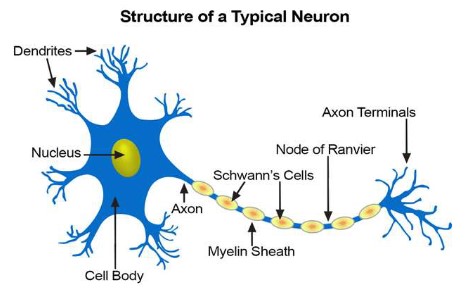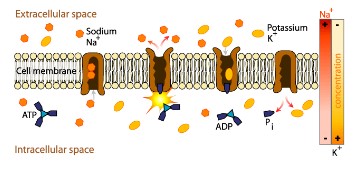Topic 6: Human physiology
6.5 Neurons and Synapses
Neuron

Saltatory conduction
- Nerve fibres conduct electrical impulses along the length of their axons. Some of these axons such as interneurons are unmyelinated, and therefore the impulse travels much slower
- The greater the diameter, the greater the speed of the nerve impulse
- Some axons are surrounded by a mixture of protein and phospholipids called myelin that collectively form a myelin sheath
- Many layers of myelin are deposited around the axon by special cells called Schwann cells
- The myelin sheath insulates the axon and greatly increases the speed of the nerve impulse
- In between the myelin are gaps called the nodes of Ranvier
- In myelinated neurons, the impulse can jump from one node to the next. This is called saltatory conduction
- This allows myelinated neurons to conduct impulses up to 100x faster than unmyelinated axons
Resting potential
- The time period when a neuron that is not conducting a nerve impulse, but is ready to conduct one, is called the resting potential.
- This membrane potential is due to an imbalance of positive and negative charges across the membrane
- Sodium-potassium pumps pump \(Na^+\) out of the axon and \(K^+\) into the axon
- Three \(Na^+\) are pumped out of the neuron and two \(K^+\) are pumped into the neuron
- This creates a concentration gradient of \(Na^+\) (outside to in) and of \(K^+\) (inside to out)
- The membrane is also much more permeable to \(K^+\) as \(Na^+\), so \(K^+\) diffuses back out of the neuron through leak channels
- This means the Na+ concentration is much greater outside the neuron
- There are also negatively charged ions permanently located in the cytoplasm of the neuron
- These conditions create a resting membrane potential of -70 mV inside the neuron

Depolarisation
- The arrival of an action potential caused by a stimulus causes a depolarization of the membrane as \(Na^+\) channels begin to open.
- If the membrane potential reaches a threshold level of -55mV. Many more voltage-gated \(Na^+\) channels open and \(Na^+\) rapidly diffuses into the neuron
- The inside of the neuron becomes more positively charged than the outside of the neuron (depolarization)
- The voltage can rush up to +40mV
Repolarisation
- \(K^+\) channels open and \(K^+\) ions diffuse out of the neuron making the inside negative again (repolarization)
- After the action potential, there is a refractory period where the impulse cannot go back in the same direction. This ensures a one-way nerve impulse

Properties of action potential
- As a depolarization occurs in one part of the neuron, the positive charge triggers the \(Na^+\) channels to open in the nearby regions causing an action potential to occur.
- This action potential will cause a depolarization in the next region.
- The propagation of action potentials will continue along the axon of the neuron.
- Nerve impulses move in one direction along the neuron from one end of the neuron to the other end
- A refractory period occurs after depolarization which prevent the electrical impulse from traveling backwards along the axon

Oscilloscope traces of action potential

Synapse
- Synapses are junctions or structures between the pre-synaptic and post-synaptic membrane of two cells in the nervous system
- The junction can be between a neuron and an effector such as a muscle or a gland
- It can be between two different neurons.
- A junction also exists between the sense receptor cells and the sensory neurons
- Neurotransmitters are chemicals diffuse across a synapse from pre-synaptic membrane to post-synaptic membrane to send a signal to the next cell
- As the nerve impulse reaches the axon terminal of the pre-synaptic neuron, the positive charge from the depolarization causes voltage-gated channels
permeable to \(Ca^{2+}\) to open. - \(Ca^{2+}\) flows into the pre-synaptic neuron increasing the amount of \(Ca^{2+}\) in the pre-synaptic neuron.
- This \(Ca^{2+}\) causes vesicles containing neurotransmitters to bind to the membrane and release their neurotransmitters into the synaptic cleft (space between pre and post synaptic neuron).
- These neurotransmitters diffuse across the synaptic cleft and bind to receptor sites on the membrane of the post synaptic neuron.
- The binding of these neurotransmitters open ion channels allowing ions such as \(Na^+\) to diffuse into the post synaptic neuron.
- This influx of positive charge possibly leads to an action potential and a depolarization in the post synaptic neuron.
- The neurotransmitter is reabsorbed by the pre-synaptic neuron or broken down in the synapse by enzymes

- The threshold potential is the critical level to which a membrane potential must be reach in order to initiate an action potential
- Neurons fire or a nerve impulse is generated by an “all or nothing”
- When a stimulus occurs, some \(Na^+\) channels open causing the membrane potential to become more positive
- If enough \(Na^+\) diffuses into the neuron and action potential is generated
- At a synapse, binding of a neurotransmitter at the post-synaptic membrane causes \(Na^+\) to diffuse into the neuron (if excitatory)
- This can cause a depolarization of the neuron if enough neurotransmitters are released
Acetylcholine
- Acetylcholine is a neurotransmitter
- It is largely used at the neuromuscular junction, meaning it is released by motor neurons and binds to receptors on muscles
- It is also used in the autonomic nervous system
- Acetylcholine is created in the pre-synaptic terminal by combining a water soluble nutrient called choline with an acetyl group
- Acetylcholine is secreted by the pre-synaptic membrane of a neuron
- The neurotransmitter diffuses across the synapse and binds to a receptor on the post synaptic membrane (causing an action potential if a threshold is reached)
- Once it has released from the receptor, an enzyme called acetylcholinesterase breaks down into choline and acetate
- Choline is reabsorbed back into the pre-synaptic neuron where it is combined with another acetyl group to form another acetylcholine neurotransmitter
Pesticides using neonicotinoids
- Neonicotinoids bind to acetylcholine receptors in cholinergic synapses in the CNS of insects
- Acetylcholinesterase does not break down neonicotinoids therefore binding is irreversible
- Acetylcholine now can’t bind and neural transmission is stopped
- The insects go through paralysis and then death
- A benefit to this pesticide is that it is very effective in killing pests and it is not highly toxic to humans and mammals
- The problem is that it also effects beneficial insects such as honey bees. There is conflicting evidence if this is the case or not
- Many places such as the EU and Ontario, Canada has banned neonicotinoid pesticides

